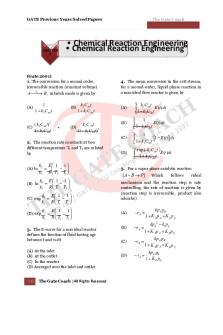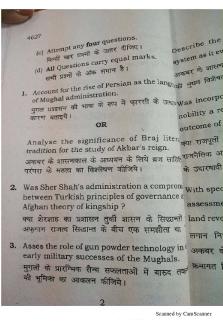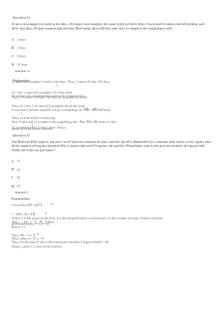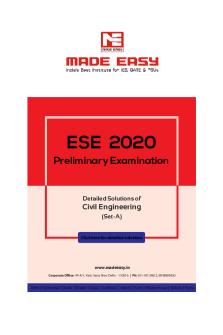GATE Solved Question Papers for Aerospace Engineering - AE PDF

| Title | GATE Solved Question Papers for Aerospace Engineering - AE |
|---|---|
| Author | AglaSem EduTech |
| Pages | 68 |
| File Size | 1.9 MB |
| File Type | |
| Total Views | 34 |
Summary
SOLVED PAPERS GATE AEROSPACE ENGINEERING (AE) A comprehensive study guide for GATE aglaem .com CONTENTS • Introduction • Question Paper Pattern • Design of Questions • Marking Scheme • Syllabus • Previous Year Solved Papers ◦ Solved Question Paper 2015 ◦ Answer Key 2015 ◦ Solved Question paper 2014 ...
Description
SOLVED PAPERS
GATE AEROSPACE ENGINEERING (AE)
A comprehensive study guide for GATE
aglaem
.com
CONTENTS • • • • • •
Introduction Question Paper Pattern Design of Questions Marking Scheme Syllabus Previous Year Solved Papers ◦ Solved Question Paper 2015 ◦ Answer Key 2015 ◦ Solved Question paper 2014 ◦ Answer Key 2014 ◦ Solved Question Paper 2013 ◦ Answer Key 2013 ◦ Solved Question Paper 2012 ◦ Answer Key 2012
Introduction The Graduate Aptitude Test in Engineering (GATE) is the all India level examination conducted by the Indian Institute of Science and seven Indian Institutes of Technology (IITs).
A crucial part of GATE preparation is to solve and practice using previous year GATE papers. Solving previous year GATE papers help the candidate in understanding the exam pattern, knowing the level of difficulty of questions, and analyzing preparation.
While attempting to solve any previous year GATE paper, it is advisable that it is done in a simulated test environment. This means, that the candidate sets a timer to countdown to test time, makes sure there is no other distraction, and then sits down to take the test as if he / she is in the exam hall. After attempting the paper, check how many questions you could get right in the first attempt. Analyse the strong and weak areas of preparation, and accordingly devise a study schedule or revision pattern. After going through those areas where in the first attempt could not do well, try the next paper.
Almost all of the engineering colleges in India take admission in M.Tech courses on the basis of GATE scores. Apart from that, PSUs also recruit students directly on this basis.
To score high in this elite examination is tough, but quite achievable.
________________________________________________________________ GATE Previous Year Solved Papers by
Question Paper Pattern for GATE 2016 In all the papers, there will be a total of 65 questions carrying 100 marks, out of which 10 questions carrying a total of 15 marks are in General Aptitude (GA). In the papers bearing the codes AE, AG, BT, CE, CH, CS, EC, EE, IN, ME, MN, MT, PE, PI, TF and XE, the Engineering Mathematics will carry around 15% of the total marks, the General Aptitude section will carry 15% of the total marks and the remaining 70% percentage of the total marks is devoted to the subject of the paper.
In the papers bearing the codes AR, CY, EY, GG, MA, PH and XL, the General Aptitude section will carry 15% of the total marks and the remaining 85% of the total marks is devoted to the subject of the paper.
GATE 2016 would contain questions of two different types in various papers:
(i) Multiple Choice Questions (MCQ) carrying 1 or 2 marks each in all papers and sections. These questions are objective in nature, and each will have a choice of four answers, out of which the candidate has to mark the correct answer(s).
(ii) Numerical Answer Questions of 1 or 2 marks each in all papers and sections. For these questions the answer is a real number, to be entered by the candidate using the virtual keypad. No choices will be shown for this type of questions.
________________________________________________________________ GATE Previous Year Solved Papers by
Design of Questions for GATE 2016 The questions in a paper may be designed to test the following abilities: (I) Recall: These are based on facts, principles, formulae or laws of the discipline of the paper. The candidate is expected to be able to obtain the answer either from his/her memory of the subject or at most from a one-line computation. Example Q. During machining maximum heat is produced (A) in flank face (B) in rake face (C) in shear zone (D) due to friction between chip and tool
(ii) Comprehension: These questions will test the candidate’s understanding of the basics of his/her field, by requiring him/her to draw simple conclusions from fundamental ideas. Example Q. A DC motor requires a starter in order to (A) develop a starting torque (B) compensate for auxiliary field ampere turns (C) limit armature current at starting (D) provide regenerative braking
(iii) Application: In these questions, the candidate is expected to apply his/her knowledge either through computation or by logical reasoning. Example Q. The sequent depth ratio of a hydraulic jump in a rectangular channel is 16.48. The Froude number at the beginning of the jump is: (A) 5.0 (B) 8.0 (C) 10.0 (D) 12.0 Examples of each of this design is given in the types of questions above.
________________________________________________________________ GATE Previous Year Solved Papers by
The questions based on the above logics may be a mix of single standalone statement/phrase/data type questions, combination of option codes type questions or match items type questions.
(iv) Analysis and Synthesis: In these questions, the candidate is presented with data, diagrams, images etc. that require analysis before a question can be answered. A Synthesis question might require the candidate to compare two or more pieces of information. Questions in this category could, for example, involve candidates in recognising unstated assumptions, or separating useful information from irrelevant information.
________________________________________________________________ GATE Previous Year Solved Papers by
GATE 2016 Marking Scheme For 1-mark multiple-choice questions, 1/3 marks will be deducted for a wrong answer.
Likewise, for 2-marks multiple-choice questions, 2/3 marks will be deducted for a wrong answer. There is no negative marking for numerical answer type questions. General Aptitude (GA) Questions
In all papers, GA questions carry a total of 15 marks. The GA section includes 5 questions carrying 1 mark each (sub-total 5 marks) and 5 questions carrying 2 marks each (sub-total 10 marks).
Question Papers other than GG, XE and XL
These papers would contain 25 questions carrying 1 mark each (sub-total 25 marks) and 30 questions carrying 2 marks each (sub-total 60 marks). The question paper will consist of questions of multiple choice and numerical answer type. For numerical answer questions, choices will not be given. Candidates have to enter the answer (which will be a real number, signed or unsigned, e.g. 25.06, -25.06, 25, -25 etc.) using a virtual keypad. An appropriate range will be considered while evaluating the numerical answer type questions so that the candidate is not penalized due to the usual round-off errors.
GG (Geology and Geophysics) Paper
Apart from the General Aptitude (GA) section, the GG question paper consists of two parts: Part A and Part B. Part A is common for all candidates. Part B contains two sections: Section 1 (Geology) and Section 2 (Geo-physics). Candidates will have to attempt questions in Part A and either Section 1 or Section 2 in Part B.
Part A consists of 25 multiple-choice questions carrying 1-mark each (sub-total 25 marks and some of these may be numerical answer type questions). Each section in Part B (Section 1 and Section 2) consists of 30 multiple choice questions carrying 2 marks each (sub-total 60 marks and some of these may be numerical answer type questions).
________________________________________________________________ GATE Previous Year Solved Papers by
XE Paper (Engineering Sciences)
In XE paper, Engineering Mathematics section (Section A) is compulsory. This section contains 11 questions carrying a total of 15 marks: 7 questions carrying 1 markeach (subtotal 7 marks), and 4 questions carrying 2 marks each (sub-total 8 marks). Some questions may be of numerical answer type questions.
Each of the other sections of the XE paper (Sections B through G) contains 22 questions carrying a total of 35 marks: 9 questions carrying 1 mark each (sub-total 9marks) and 13 questions carrying 2 marks each (sub-total 26 marks). Some questions may be of numerical answer type.
XL Paper (Life Sciences)
In XL paper, Chemistry section (Section H) is compulsory. This section contains 15 questions carrying a total of 25 marks: 5 questions carrying 1 mark each (sub-total5 marks) and 10 questions carrying 2-marks each (sub-total 20 marks). Some questions may be of numerical answer type.
Each of the other sections of the XL paper (Sections I through M) contains 20 questions carrying a total of 30 marks: 10 questions carrying 1 mark each (sub-total 10 marks) and 10 questions carrying 2 marks each (sub-total 20 marks). Some questions may be of numerical answer type.
Note on Negative Marking for Wrong Answers
For a wrong answer chosen for the multiple choice questions, there would be negative marking. For 1-mark multiple choice questions, 1/3 mark will be deducted for a wrong answer. Likewise, for 2-mark multiple choice questions, 2/3 mark will be deducted for a wrong answer. However, there is no negative marking for a wrong answer in numerical answer type questions.
________________________________________________________________ GATE Previous Year Solved Papers by
Syllabus for General Aptitude (GA) Verbal Ability: English grammar, sentence completion, verbal analogies, word groups, instructions, critical reasoning and verbal deduction.
Numerical Ability: Numerical computation, numerical estimation, numerical reasoning and data interpretation.
Syllabus for Aerospace Engineering (AE) Section1: Engineering Mathematics
Core Topics
Linear Algebra: Vector algebra, Matrix algebra, systems of linear equations, rank of a matrix, eigenvalues and eigenvectors.
Calculus: Functions of single variable, limits, continuity and differentiability, mean value theorem, chain rule, partial derivatives, maxima and minima, gradient, divergence and curl, directional derivatives. Integration, Line, surface and volume integrals. Theorems of Stokes, Gauss and Green.
Differential Equations: First order linear and nonlinear differential equations, higher order linear ODEs with constant coefficients. Partial differential equations and separation of variables methods.
Special Topics
Fourier Series, Laplace Transforms, Numerical methods for linear and nonlinear algebraic equations, Numerical integration and differentiation.
________________________________________________________________ GATE Previous Year Solved Papers by
Section 2: Flight Mechanics
Core Topics
Basics: Atmosphere: Properties, standard atmosphere. Classification of aircraft. Airplane (fixed wing aircraft) configuration and various parts;
Airplane performance: Pressure altitude; equivalent, calibrated, indicated air speeds; Primary flight instruments: Altimeter, ASI, VSI, Turn-bank indicator. Drag polar; takeoff and landing; steady climb & descent, absolute and service ceiling; cruise, cruise climb, endurance or loiter; load factor, turning flight, V-n diagram; Winds: head, tail & cross winds;
Static stability: Angle of attack, sideslip; roll, pitch & yaw controls; longitudinal stick fixed & free stability, horizontal tail position and size; directional stability, vertical tail position and size; dihedral stability. Wing dihedral, sweep & position; hinge moments, stick forces;
Special Topics
Dynamic stability: Euler angles; Equations of motion; aerodynamic forces and moments, stability & control derivatives; decoupling of longitudinal and lateral-directional dynamics; longitudinal modes; lateral-directional modes.
Section 3: Space Dynamics
Core Topics
Central force motion, determination of trajectory and orbital period in simple cases.
Special Topics: Orbit transfer, in-plane and out-of-plane.
Section 4: Aerodynamics
Core Topics
________________________________________________________________ GATE Previous Year Solved Papers by
Basic Fluid Mechanics: Conservation laws: Mass, momentum (Integral and differential form); Potential flow theory: sources, sinks, doublets, line vortex and their superposition; Viscosity, Reynold's number.
Airfoils and wings: Airfoil nomenclature; Aerodynamic coefficients: lift, drag and moment; Kutta-Joukoswki theorem; Thin airfoil theory, Kutta condition, starting vortex; Finite wing theory: Induced drag, Prandtl lifting line theory; Critical and drag divergence Mach number.
Compressible Flows: Basic concepts of compressibility, Conservation equations; One dimensional compressible flows, Fanno flow, Rayleigh flow; Isentropic flows, normal and oblique shocks, Prandtl-Meyer flow; Flow through nozzles and diffusers.
Special Topics
Elementary ideas of viscous flows including boundary layers; Wind Tunnel Testing: Measurement and visualization techniques.
Section 5: Structures
Core Topics
Strength of Materials: States of stress and strain. Stress and strain transformation. Mohr's Circle. Principal stresses. Three-dimensional Hooke's law. Plane stress and strain; Failure theories: Maximum stress, Tresca and von Mises; Strain energy. Castigliano's principles. Analysis of statically determinate and indeterminate trusses and beams. Elastic flexural buckling of columns.
Flight vehicle structures: Characteristics of aircraft structures and materials. Torsion, bending and flexural shear of thin-walled sections. Loads on aircraft.
Structural Dynamics: Free and forced vibrations of undamped and damped SDOF systems. Free vibrations of undamped 2-DOF systems.
________________________________________________________________ GATE Previous Year Solved Papers by
Special Topics
Vibration of beams. Theory of elasticity: Equilibrium and compatibility equations, Airy’s stress function.
Section 6: Propulsion
Core Topics
Basics:
Thermodynamics,
boundary
layers
and
heat
transfer
and
combustion
thermochemistry.
Thermodynamics of aircraft engines: Thrust, efficiency and engine performance of turbojet, turboprop, turbo shaft, turbofan and ramjet engines, thrust augmentation of turbojets and turbofan engines. Aerothermodynamics of non-rotating propulsion components such as intakes, combustor and nozzle.
Axial compressors: Angular momentum, work and compression, characteristic performance of a single axial compressor stage, efficiency of the compressor and degree of reaction. Axial turbines: Axial turbine stage efficiency
Centrifugal compressor: Centrifugal compressor stage dynamics, inducer, impeller and diffuser.
Rocket propulsion: Thrust equation and specific impulse, vehicle acceleration, drag, gravity losses, multi-staging of rockets. Classification of chemical rockets, performance of solid and liquid propellant rockets.
No Special Topics
________________________________________________________________ GATE Previous Year Solved Papers by
GATE Previous Year Solved Paper Aerospace Engineering - AE
2012-15
________________________________________________________________
GATE Previous Year Solved Papers by
GATE 2015 Solved Paper Aerospace Engineering - AE Duration: 180 minutes
Maximum Marks: 100
Read the following instructions carefully. 1. To login, enter your Registration Number and password provided to you. Kindly go through the various symbols used in the test and understand their meaning before you start the examination. 2. Once you login and after the start of the examination, you can view all the questions in the question paper, by clicking on the View All Questions button in the screen. 3. This question paper consists of 2 sections, General Aptitude (GA) for 15 marks and the subject specific GATE paper for 85 marks. Both these sections are compulsory. The GA section consists of 10 questions. Question numbers 1 to 5 are of 1-mark each, while question numbers 6 to 10 are of 2-mark each. The subject specific GATE paper section consists of 55 questions, out of which question numbers 1 to 25 are of 1-mark each, while question numbers 26 to 55 are of 2-mark each. 4. Depending upon the GATE paper, there may be useful common data that may be required for answering the questions. If the paper has such useful data, the same can be viewed by clicking on the Useful Common Data button that appears at the top, right hand side of the screen. 5. The computer allotted to you at the examination center runs specialized software that permits only one answer to be selected for multiple-choice questions using a mouse and to enter a suitable number for the numerical answer type questions using the virtual keyboard and mouse. 6. Your answers shall be updated and saved on a server periodically and also at the end of the examination. The examination will stop automatically at the end of 180 minutes. 7. In each paper a candidate can answer a total of 65 questions carrying 100 marks. 8. The question paper may consist of questions of multiple choice type (MCQ) and numerical answer type. 9. Multiple choice type questions will have four choices against A, B, C, D, out of which only ONE is the correct answer. The candidate has to choose the correct answer by clicking on the bubble (⃝) placed before the choice. 10. For numerical answer type questions, each question will have a numerical answer and there will not be any choices. For these questions, the answer should be enteredby using the virtual keyboard that appears on the monitor and the mouse. 11. All questions that are not attempted will result in zero marks. However, wrong answers for multiple choice type questions (MCQ) will result in NEGATIVE marks. For all MCQ questions a wrong answer will result in deduction of⅓ marks for a 1-mark question and ⅔ marks for a 2-mark question. 12. There is NO NEGATIVE MARKING for questions of NUMERICAL ANSWER TYPE. 13. Non-programmable type Calculator is allowed. Charts, graph sheets, and mathematical tables are NOT allowed in the Examination Hall. You must use the Scribble pad provided to you at the examination centre for all your rough work. The Scribble Pad has to be returned at the end of the examination. Declaration by the candidate: “I have read and understood all the above instructions. I have also read and understood clearly the instructions given on the admit card and shall follow the same. I also understand that in case I am found to violate any of these instructions, my candidature is liable to be cancelled. I also confirm that at the start of the examination all the computer hardware allotted to me are in proper working condition”.
__________________________________________________________ GATE Previous Year Solved Papers by
GATE 2015 General Aptitude - GA _______________________________________________________________ Q.1 to Q.5 carry 1 mark each & Q. 6 to Q.10 carry 2 marks each Question Number : 1 Question Type : MCQ Choose the appropriate word/phrase, out of the four options given below, to complete the following sentence: Apparent lifelessness ______________ dormant life. (A) harbours (B) leads to (C) supports (D) affects Question Number : 2 Question Type : MCQ Fill in the blank with the correct idiom/phrase. That boy from the town was a __________ in the sleepy village. (A) dog out of herd (B) sheep from the heap (C) fish out of water (D) bird from the flock Question Number : 3 Question Type : MCQ Choose the statement where underlined word is used correctly. (A) When the teacher eludes to different authors, he is being elusive. (B) When the thief keeps eluding the polices, he is being...
Similar Free PDFs

CRE GATE Question paper
- 28 Pages

SPCC viva question for engineering
- 36 Pages

English QUESTION PAPERS
- 4 Pages

IOT&WSN Question Papers
- 5 Pages

Previous Year Question Papers
- 19 Pages

DSP Question Papers 1
- 2 Pages

BEE Question Papers
- 92 Pages

LLB Exam Question Papers
- 29 Pages

All-Question Papers
- 52 Pages

Human Rights Question Papers
- 15 Pages

Solved Question Paper (4)
- 10 Pages
Popular Institutions
- Tinajero National High School - Annex
- Politeknik Caltex Riau
- Yokohama City University
- SGT University
- University of Al-Qadisiyah
- Divine Word College of Vigan
- Techniek College Rotterdam
- Universidade de Santiago
- Universiti Teknologi MARA Cawangan Johor Kampus Pasir Gudang
- Poltekkes Kemenkes Yogyakarta
- Baguio City National High School
- Colegio san marcos
- preparatoria uno
- Centro de Bachillerato Tecnológico Industrial y de Servicios No. 107
- Dalian Maritime University
- Quang Trung Secondary School
- Colegio Tecnológico en Informática
- Corporación Regional de Educación Superior
- Grupo CEDVA
- Dar Al Uloom University
- Centro de Estudios Preuniversitarios de la Universidad Nacional de Ingeniería
- 上智大学
- Aakash International School, Nuna Majara
- San Felipe Neri Catholic School
- Kang Chiao International School - New Taipei City
- Misamis Occidental National High School
- Institución Educativa Escuela Normal Juan Ladrilleros
- Kolehiyo ng Pantukan
- Batanes State College
- Instituto Continental
- Sekolah Menengah Kejuruan Kesehatan Kaltara (Tarakan)
- Colegio de La Inmaculada Concepcion - Cebu




